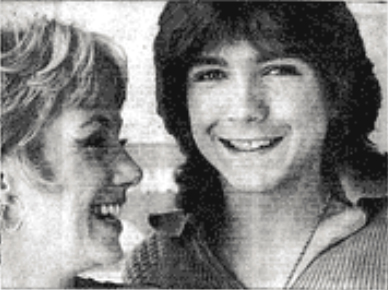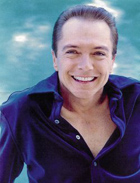
David Cassidy in the News
Two Partridges in a money tree
September 5, 1971

By Aljean Harmetz
The New York Times
“IF WE could only auction off his gallbladder,” said a cynic, “we could make a fortune.”
HOLLYWOOD
“Auction off the whole gallbladder, hell,” said a more businesslike cynic. “We should sell each gallstone separately.”
Although Screen Gems has turned down requests to bronze David Cassidy's gallstones — he was unexpectedly hospitalized in July--and to embed his hair clippings in plastic, they are doing a brisk sale in “The Partridge Family” coloring books, lunch boxes, paper dolls, comic books, wiggle postcards, children's dresses, paperback mystery novels, Patti Partridge dolls, and two record albums that have sold over a million copies each. During April and May of 1971, Screen Gems' royalties from “Partridge Family” bubble gum alone were $59,000.
Last September “The Partridge Family” was simply one of 23 new prime-time television shows hoping to make it through the year—a situation comedy about a widow (Shirley Jones) with five children (including her real stepson, David Cassidy) who is forced to become a permanent member of her children's rock group when their girl singer gets the mumps. It was, at a quick glance, neither more nor less artificial than the situation comedies that surrounded it or opposed it. (To an untrained eye, situation comedies, like cheap children's watches, seem to have interchangeable viscera.) “The Partridge Family” belonged to that large subgroup starring beautiful/handsome widows/widowers with large numbers of adorable children. The music was pleasant enough, sweetly sentimental under its rock surface. In the time sequence of childhood, the music was a cut above bubble gum music, a cut below Three Dog Night. The realities of life as a touring rock group were rejected in favor of fairy tales such as an episode about a prisoner who quarantines the Partridges when they perform at the state prison.
“By the fifth Nielsen, I knew we had a winner,” says executive producer Bob Claver. That fifth Nielsen (Oct. 23, 1970) showed “The Partridge Family” with a 17.5 rating and its competition a footstep behind at 16.8 (Andy Griffith's “Headmaster”) and 16.3 (“Name of the Game”). By December the show was in the Top 10; “I Think Love You,” the show's first record, was well on its way to selling 3,500,000 copies; and David Cassidy as Keith, oldest of the five Partridge children, was well on his way to having a million pubescent girls fighting over his gallbladder.
Since adults rarely chew bubble gum, it might be easy to dismiss “The Partridge Family” (ABC, Fridays at 8:30) as another in the series of children's hours from “Davy Crockett” to “The Monkees” that have their hot season in the sun and then melt, leaving something of a chocolate mess behind. One survey did indeed call “The Partridge Family” the highest rated TV program among children 6 to 11. But the audience breakdown also showed that, although 38 per cent of “The Partridge Family” viewers are children, 28 per cent are women over the age of 19 and 19 per cent are grown men.
“The Partridge Family” started as “Family Business” in the typewriter of Bernie Slade in August, 1969. Slade, who had already created “The Flying Nun,” “Love on a Rooftop,” and “Mr. Deeds Goes to Town,” had a contract with Screen Gems, Columbia's TV subsidiary, to create three pilots a year. To get his new show on the air, he would have to create something different enough to be interesting, familiar enough to sell to a network. Remembering “The Sound of Music,” he decided “to try a combination that hadn't been tried before on television, a show that had a straight story line but also had music.”
“The Monkees” may not have been in the hack of Slade's mind as he sat down at his typewriter but, at one time or another, it was in the back of the minds of most people connected with “The Partridge Family”—both as a goal and a warning. The emphasis on teen-age music had made a success of “The Monkees.” But the success had come apart in Screen Gems' hands long before it should have. According to Ed Justin, head of merchandising for 16 years at Screen Gems, that was partly due to the rapidly enlarged egos of the four performers. “The mistake we made on ‘The Monkees,’” says Justin, “is that we didn't poison the four actors the first week.” As soon as he read the pilot script of “The Partridge Family,” Justin “knew that the show would be highly merchandisable. I've been at this so long I can smell it.”
The day the script was out of Slade's typewriter, it was sent to Shirley Jones. “I thought it had the best chance of success of any pilot script I'd ever read,” says Shirley. “For a situation comedy, it was written honestly; and the Partridges weren't a fairy-tale, candy-box family.” She was never to waver in her absolute certainty that the show would be a success — even when everyone else connected with the show was sure it would be a failure.
As producer, Claver—a sensible, intelligent man with a teen-age daughter of his own—now had to find five children. There would be a male teen-ager to attract teenage girls to the show, a female teen-ager, and three more-or-less-little children. Although the Partridge children were supposed to sing or play musical instruments, Claver did not look for children with musical talent. “If we were to have looked for five kids who could act and sing, we'd have been looking for five years.” As it was, Claver interviewed 850 children before deciding to test 10—two for each role. They were tested and chosen “in relationship to each other—for the chemistry.”
From the beginning, Shirley Jones was aware that her stepson was being considered. The only person at Screen Gems who knew of their relationship was casting director Rene Valente. She withheld that information until Cassidy became a finalist. (The other finalist for the role of 16-year-old Keith Partridge was John David Carson who made his own splash last year as the unwilling virgin in “Pretty Maids All in Row.”) Within minutes Shirley was being asked how well she got along with her stepson. Shirley Jones and actor Jack Cassidy were married when David was 7 years old. Whatever resentments may have been felt then have long since been dissipated. She got along fine, she told them, with her stepson.
Success in television comes from small accidents. Lucky as producer Claver was with David Cassidy's ambience and singing ability, he was equally lucky with 11-year-old Danny Bonaduce's ability to make anything he says sound funny. (Danny's comic ability is so obvious that one can actually believe television writer Joe Bonaduce's story that “when I moved out here six years ago I couldn't get a job. I couldn't even get arrested. But everybody we met wanted Danny. Against our will, we finally let him give it a try.”) A random sampling of children in West Los Angeles shows that almost all children under the age of 12 —male and female — turn on “The Partridge Family” not for David Cassidy but for Danny Bonaduce. In fact, for young children, David Cassidy runs a poor third to Shirley Jones.
The pilot was finished in December, 1969. ABC policy then demanded that it pass an audience research test. “A bunch of unwilling adults were dragged into a theater at 8:30 at night to watch ‘The Partridge Family,’” says Claver. “And we knew the show wouldn't get on the air unless it had high numbers.” The pilot was “a smashing success,” and the network decided to go ahead. When, a few months later, the first six shows were shown to a similar audience, the results were not exactly smashing. “In fact, they hated it,” says Claver. The network was gloomy. Claver was gloomy. “How could they like the pilot and hate the other six shows?”
Claver soon had reason to be even gloomier. ABC had decided to put “The Partridge Family” opposite Andy Griffith's new show. “We were all sure the show would be killed by Griffith,” says Claver. “After all, he was a proven television star. My only hope was if we were lucky we'd get enough rating points so the network would think it was worth moving us to a better spot. I used to go home at night and tell my wife, ‘Poor Shirley. She doesn't understand. She still thinks it's going to be all right.’”
And it was.
What ingredient or combination of ingredients caused “The Partridge Family” to rise like a helium balloon above its competitors while so many seemingly similar television shows huddle forlornly in the Nielsen doldrums, unable to franchise even one coloring book or paper doll?
“A lot of kids would like to be in that family. It seems like fun. I'd like to be in that family if I were a kid,” says Claver.
“It's the emphasis on teen-age music,” says Ed Justin.
“You can't just say the music is responsible,” says David Cassidy. “It's the chemistry between the actors. The show's positive. We're not trying to bring anyone down.”
“Let's face it,” says one of Cassidy's agent-managers. “David Cassidy is the ‘Partridge Family’ phenomenon.”
Cassidy is a frail, courteous, 21-year-old boy with hair the color of bronze. As his car leaves the studio, he crouches in the passenger seat, pretending to be asleep. The teen-age girls waiting at the gate squeal and point, but the car is going too fast for them to approach him. “It's strange,” Cassidy says. “They wait all day to see you. There's pleasure in that, hut I'd rather not deal with it now when I'm hot and tired. Right now I feel like saying, ‘Don't wait out here. It's too hot. Go have fun.’” It is Tuesday, Aug. 10, Cassidy's first day back at work since his operation.
His gallbladder was removed at 12:30 P.M. Tuesday, July 13. By dinnertime his fans were hiding in the elevator of Los Angeles' Mount Sinai Hospital, perhaps in the hope “of seeing me with the intravenous still in my arms.” Says Cassidy's manager, Ruth Aarons, “I didn't know whether to hire round-the-clock nurses or Pinkerton guards.” During his two - week stay in the hospital, he received 5,000 get well cards and several hundred presents, including a large number of candles, incense, love beads and “more stuffed partridges than I ever knew existed.”
Of his own success, Cassidy—who opens doors for ladies, seems spotlessly wholesome, and, speaks the King's English only occasionally spiced with “I thought it was really out of sight” or “I know when somebody's shucking me”— muses, “Who can say why one person is singled out? Maybe because of the way I talk or look. Possibly because I'm uncomplicated, clean. There's no threat involved.”
Says Chuck Laufer, the most successful proprietor of teen-age fan magazines, “Cassidy has the Look. It's something the kids can empathize with—an emaciated, wistful quality.” (At 5 feet 8 inches, Cassidy normally weighs 132 pounds but he has lost 18 pounds with his operation.) Laufer expects Cassidy to last the usual two years before the current pubescent girls outgrow him and go on to dating for themselves rather than vicariously.
Yet there is still the question of how much of “The Partridge Family's” success is due to David Cassidy and how much of David Cassidy is due to the show's success.
“It's Shirley Jones who makes it all happen,” says writer Bernie Slade. “Kids loved ‘The Monkees’ but their parents hated and the result was no more Monkees. Shirley is our adult point of view, a parent figure who appeals to adults for her beauty and her warmth and her brains.”
“I've always felt that I'm right for television,” says Shirley Jones. She looks rather like an oversized canary — yellow slacks, yellow shirt, yellow sandals propped up on a scarred wooden coffee table in the living room of her Beverly Hills home. “People trust me and you have to be trusted to be in television. When you're in someone's house each week, they have to know they can trust you.”
